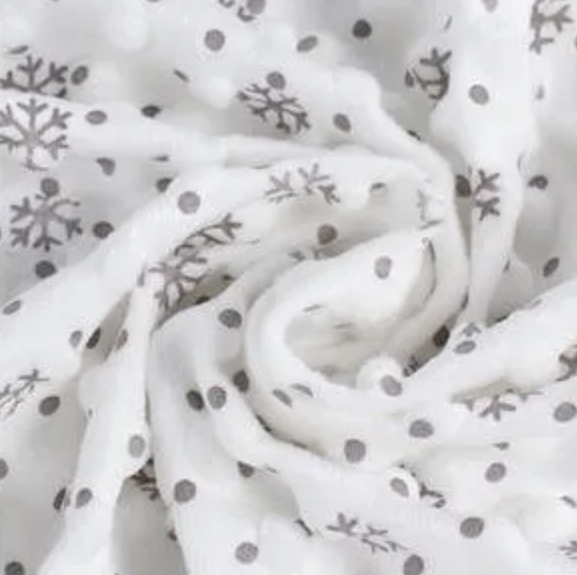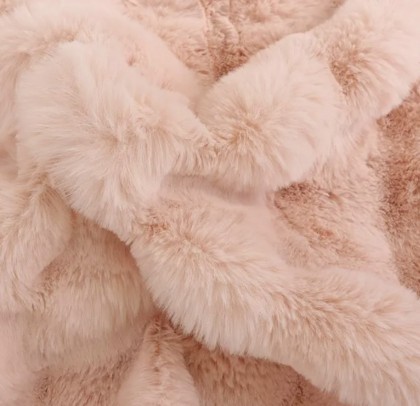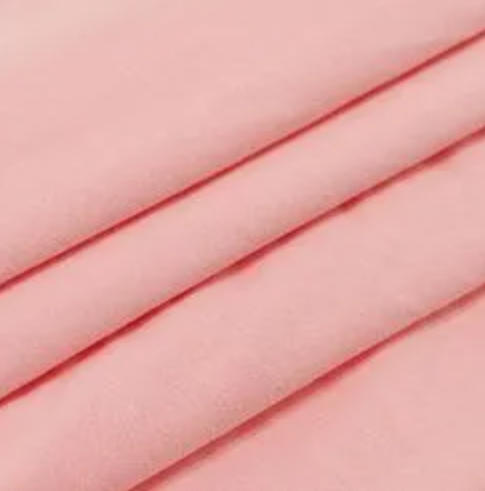When you wonder how many yards of fabric for fleece tie blanket projects you need, the answer depends on the blanket size. For a baby, you use 1 yard per side. For a child, 1.5 yards works best. For an adult, most crafters choose 2 yards for full coverage and comfort.
Use this quick-reference chart to help you pick the right amount:
| Age Group | Recommended Yardage | Approximate Size (inches) |
|---|---|---|
| Baby | 1 | 36 x 60 |
| Child | 1.5 | 54 x 60 |
| Teen/Adult | 2-2.5 | 60 x 90 |
You can confidently start your project with these standard measurements. This guide helps you select the right fleece and avoid common mistakes.
Key Takeaways
- Choose fabric yardage based on blanket size: 1 yard for babies, 1.5 yards for children, and 2 to 2.5 yards for adults.
- Use fleece fabric width (usually 54 to 60 inches) to cover the blanket width, and buy enough length in yards for the blanket’s length.
- Prepare fleece by trimming edges, aligning layers, and cutting 5-inch squares from corners and 1-inch wide strips for tying.
- Tie fringe strips securely with knots to join layers and create a neat, durable edge.
- Care for your fleece blanket by washing in cold water with mild detergent, avoiding fabric softeners, and drying on low heat or air drying.
How Many Yards of Fabric for a Fleece Tie Blanket

Blanket Size Guide
When you plan your fleece tie blanket, you need to consider both the size of the person and the intended use. Most crafters choose sizes based on age group or bed size. For babies, a small blanket works best for car seats or strollers. Children often use twin-sized blankets, while adults prefer larger throws or bed-sized blankets for full coverage.
The standard width for fleece fabric usually ranges from 54 to 60 inches. This width allows you to make most blankets without joining extra fabric. If you want a king-size or oversized blanket, you may need to sew two pieces together. Always check the fabric width before you buy, as it affects how many yards you need.
Crafters often select these popular sizes:
| Blanket Category | Typical Dimensions (inches) | Corresponding Standard Bedding Size |
|---|---|---|
| Baby Blanket | 30 x 36 | Designed for infants (smaller than crib bedding) |
| Child (Twin) | 60 x 84 | Fits twin and twin XL beds |
| Adult (Queen) | 90 x 90 | Fits queen mattresses |
| Adult (King) | 108 x 92 | Fits king beds |
| Throw Blanket | 60 x 50 or 60 x 72 | Multi-purpose, decorative |
You can see that the most common question—how many yards of fabric for a fleece tie blanket—depends on these dimensions. For most throws and standard bed sizes, the fabric width covers the blanket’s width, so you only need to buy enough length.
Tip: Always buy a little extra fabric to allow for trimming, tying, and possible mistakes.
Quick-Reference Chart
You may find it helpful to compare the most popular choices among crafters. Many people use 2 yards for an adult blanket, but some prefer 2.5 or even 3 yards for taller individuals or extra coziness. For children, 1.5 yards is common, while babies need only 1 yard per side.
Here is a chart summarizing popular choices:
| User Description | Typical Blanket Size or Yardage Used | Notes |
|---|---|---|
| Adult (5’10”) | 2 yards front and back; 2.5-3 yards for bigger sizes | Kits come in 72″ or smaller sizes |
| Grandchild (14 years old) | 2.5 yards long for older child | Uses anti-pill fleece for durability |
| Average Adult | 2 yards each side; 3 yards for men; 1 yard for children | Cuts 6″ squares from corners, ties fringe |
| Taller Adult | 2.5-3 yards for 5’7″ or taller | Size depends on the recipient’s height |
| Quick Kids Blanket | 2 yards front and back | Easy and quick to make |
| Baby Car Seat Blanket | 1 yard | Small and portable |
You can also visualize the most popular blanket sizes with this chart:

While no official quick-reference chart exists from major crafting organizations, groups like Project Linus and Binky Patrol recommend similar yardages. For example, Project Linus often suggests 1.5 to 3 yards per side, depending on the recipient’s age and needs. Always check with any organization if you plan to donate your blanket.
Custom Sizes
Sometimes you want a fleece tie blanket that fits a specific bed or person. You can calculate how many yards of fabric are needed for fleece tie blanket projects by following a few simple steps:
- Measure the desired finished size of your blanket in inches.
- Check the width of your fleece fabric (usually 54-60 inches).
- If your blanket width fits within the fabric width, divide the desired length by 36 to get the number of yards. Always round up to the next whole yard.
- For blankets wider than the fabric, divide the total width by the fabric width and round up. Multiply this number by the length, then divide by 36 to get the total yardage.
- Add extra fabric for tying the edges (usually 4-6 inches on each side).
- If you use patterned fabric, add a little more to match the design.
Note: Experts recommend sketching your project on graph paper for accuracy. Always buy extra fabric for errors, pattern repeats, or future repairs.
Here is a step-by-step guide for making a custom fleece tie blanket:
- Lay out both pieces of fleece, aligning the edges.
- Trim the edges so both pieces match in size.
- Cut a 5-inch square from each corner.
- Cut 5-inch long, 1-inch-wide strips along all four sides.
- Tie each pair of strips together using your favorite knot.
If you want to make a king-size blanket, you may need up to 4 yards per side and will likely have to join two pieces of fleece. Make sure to plan for seams and extra fabric for tying.
When you ask how many yards of fabric for fleece tie blanket projects, remember to consider the fabric width, the finished size, and any extra needs for tying or joining. This approach ensures your blanket turns out just the way you want.
Choosing Fleece
Fleece Types
Selecting the right fleece type shapes the comfort and durability of your tie blanket. You will find several fleece varieties, each with unique qualities. The table below compares the most popular options:
| Fleece Type | Thickness & Weight | Texture & Softness | Typical Use/Properties |
|---|---|---|---|
| Polar Fleece | Thick, durable, heavier | Warm, robust | Heavier blankets, for outdoor use |
| Microfleece | Thinner, lighter | Smooth surface | Layering, milder weather |
| Coral Fleece | Medium thickness | Softer, fuzzier, velvety on both sides | Plush feel, cozy throws |
| Plush Fleece (Minky) | Longer fibers, somewhat thick | Very soft, faux fur-like | Luxurious, extra-soft blankets |
You might also see terms like “anti-pill” or “blizzard fleece.” Anti-pill fleece resists fuzz balls and keeps its smooth look after many washes. Blizzard fleece offers plushness and warmth, with a velvety finish that stays soft over time. Microfleece stands out for its lightweight feel and moisture-wicking ability, making it a good choice for layering or warmer climates.
Tip: Anti-pill fleece costs a bit more but maintains softness and appearance longer than regular fleece. Both types do not fray, so you can easily make no-sew tie blankets.
Fabric Quality Tips
When you shop for fleece, focus on these quality indicators:
- Choose anti-pill fleece if you want your blanket to stay smooth and last longer.
- Check the weight or thickness. Heavier fleece (over 8 oz/yard) gives more warmth and a structured drape, while lighter fleece feels softer and more flexible but less warm.
- Look for pill resistance. High-quality fleece resists shedding and keeps its texture after washing.
- Consider special properties. Bamboo fleece feels soft, breathes well, and suits sensitive skin. Performance fleece adds stretch and moisture management.
- Inspect care instructions. Wash fleece with mild detergent, use cold water, and avoid high heat to keep it soft and pill-free.
You can spot quality fleece by its even texture, resistance to pilling, and clear care guidelines. These features help your tie blanket stay cozy and attractive for years.
Making the Blanket

Preparing Fabric
Before you start cutting, you need to prepare your fleece fabric for the best results. Fleece usually does not shrink or bleed color, so pre-washing is not required. However, some crafters prefer to pre-wash fleece, especially for children’s blankets, to remove any chemical odors and help the fabric relax into its natural shape. This step can prevent uneven shrinkage and ensure your blanket stays soft after washing.
Start by laying out your fleece on a large, flat surface. Trim off the selvage edges, which often look different from the rest of the fabric and can distort the blanket’s shape. Make sure to align the fabric so it follows the straight grain—this helps prevent curling and keeps your blanket square. Place one piece of fleece right side down and smooth it out. Then, lay the second piece right side up on top, smoothing both layers together. Use long pins with large heads to keep the thick fabric in place while you work.
Tip: Always cut both pieces of fleece to the same size and square the edges for a neat finish.
Cutting and Tying
Once your fabric is prepared, you can begin cutting and tying the blanket. Follow these steps for a professional look:
- Cut a 5-inch square from each corner of the layered fleece. This helps the blanket lay flat and gives a clean edge.
- Using a ruler or template, cut fringe strips that are 1 inch wide and 5 inches long along all four sides. Cut through both layers at once to keep the strips even.
- Make sure your scissors or rotary cutter are sharp for smooth, straight cuts. Use long, steady strokes rather than short snips.
- As you cut, support the fabric with your free hand to prevent shifting.
- Tie each pair of fringe strips together using a balloon knot or double knot. This secures the layers and creates a durable, attractive fringe.
For best results, keep your fringe strips uniform in width and length. Adjust the last strip on each side if needed to avoid uneven pieces.
With careful preparation and cutting, you will create a fleece tie blanket that looks great and lasts for years.
Tips and Care
Measuring and Cutting
Accurate measuring and cutting help you create a fleece tie blanket that looks professional and lasts longer. You want to use the right tools and follow smart techniques for the best results.
Recommended tools for measuring and cutting fleece:
- Fabric scissors work well for cutting fleece.
- Rotary cutters, especially when paired with a ruler, give you straight, even cuts.
- A ruler helps you measure and cut strips with precision.
- Cutting through both layers of fleece at once saves time and keeps edges aligned.
Tip: Move your ruler around the entire blanket when using a rotary cutter to keep your lines straight.
Common mistakes to avoid:
- Always cut off the selvage edges. These edges have tiny holes and can bunch up, making your blanket look uneven.
- Keep both fabric layers flat and aligned. This prevents jagged or mismatched edges.
- Use a sharp rotary cutter. Dull blades or scissors can damage the fabric and make cutting harder.
- Remove pins before cutting. This protects your blade from dulling.
- Trim all edges evenly so both layers match perfectly.
- Pin layers if needed, especially if the selvage curls.
- Use a template, like a paper napkin, to cut neat corners for easier tying.
Washing and Maintenance
Proper care keeps your fleece tie blanket soft and looking new. You should wash your blanket based on how often you use it. Blankets used daily or by pets need washing weekly or every other week. Less-used blankets can be cleaned monthly.
Best practices for washing fleece tie blankets:
- Wash your blanket alone or with other fleece items to prevent pilling.
- Turn the blanket inside out before washing to reduce surface friction.
- Use cold or lukewarm water to avoid shrinking and fabric damage.
- Select a gentle or delicate cycle to protect the fibers.
- Choose mild liquid detergents, such as Seventh Generation, which work well for sensitive skin.
- Avoid fabric softeners and dryer sheets. These leave residues that attract lint and cause pilling.
- Dry on the lowest heat setting or air dry by laying flat or using a drying rack.
- Never iron fleece, as heat can melt the fibers.
- Use a fabric shaver or de-pilling comb if you notice any pills.
Keeping up with these care tips helps your fleece tie blanket stay cozy, soft, and beautiful for years.
You now know how many yards of fabric you need for fleece tie blanket projects of any size. To recap, follow these steps for a successful blanket:
- Choose 1.5 yards for a child or 2 yards for an adult.
- Trim both fleece layers to match.
- Cut 5-inch squares from each corner.
- Cut 1-inch-wide, 5-inch-long strips along all sides.
- Tie each strip to secure the layers.
- Try using two different fleece patterns for a unique look.
- Share your finished blanket or questions in the comments to help others in the crafting community.
FAQ
How do you keep fleece from pilling after washing?
You should wash fleece in cold water on a gentle cycle. Use mild detergent. Avoid fabric softeners and dryer sheets. Dry on low heat or air dry. These steps help your blanket stay soft and pill-free.
Can you make a fleece tie blanket with only one layer?
Yes, you can use a single layer of fleece. Cut fringe around the edges and tie knots for a finished look. The blanket will feel lighter and work well for warmer weather.
What size should you cut the fringe for a tie blanket?
Cut each fringe strip about 1 inch wide and 5 inches long. This size creates strong knots and a neat edge. Use a ruler for accuracy and keep the strips even for the best results.
Do you need to pre-wash fleece before making a tie blanket?
Pre-washing fleece is optional. Fleece does not shrink much. Some people pre-wash to remove chemicals or odors. If you make a blanket for babies or sensitive skin, pre-wash it for extra safety.
Can you use patterned fleece for both sides of the blanket?
Yes, you can use two different patterns or colors. This gives your blanket a unique, reversible look. Make sure




